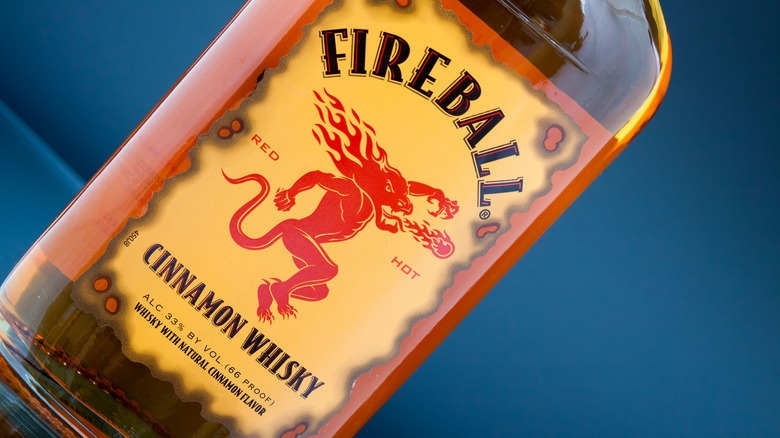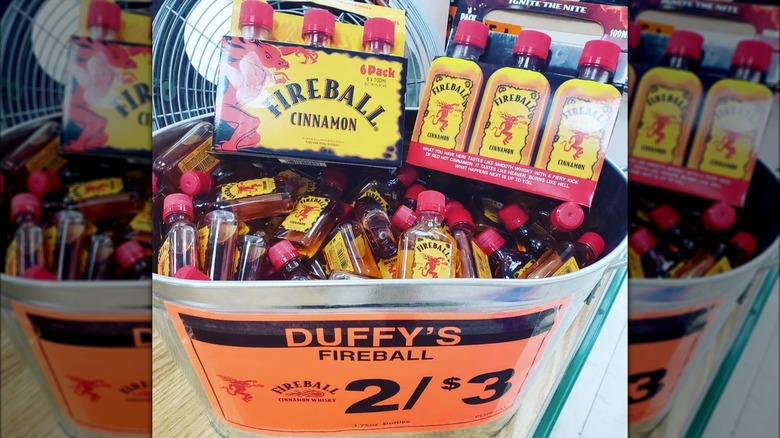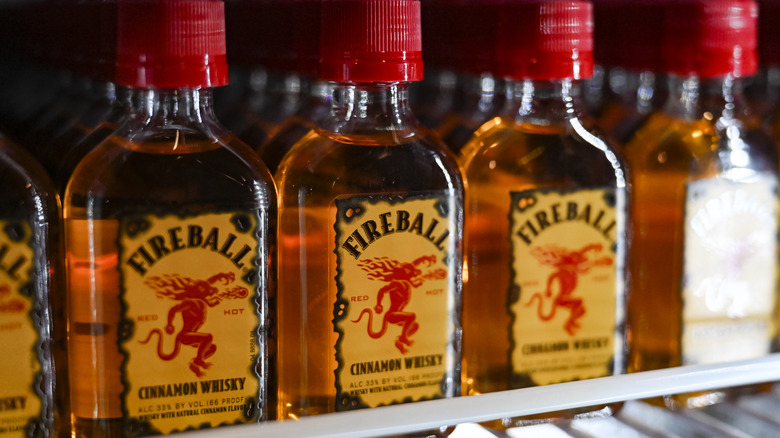Why Some Mini Bottles Of Fireball Aren't Considered Real Whiskey
Have you had a sip of Fireball Whisky recently and thought to yourself, "Hmm, this goes down way easier than I remembered!" If you have, you might have been tricked by the makers of Fireball Whisky. Rather than drinking the modern classic Cinnamon Whisky, you were likely drinking a product, launched by Fireball in 2020, called Fireball Cinnamon Malt.
Fireball Whisky was created in Canada in the 1980s and has risen in popularity across North America to become one of the largest and most popular spirits brands in the United States.
Fireball Cinnamon, as it is being branded, is sold in 50-milliliter and 100-milliliter bottles and has just half the amount of alcohol as the original Fireball Whisky. As a result, Fireball Cinnamon is considered a flavored "malt beverage" rather than whiskey, allowing the drink makers to sell Fireball Cinnamon Malt alongside beer and wine at grocery and convenience stores that are not allowed to sell hard liquor, according to the brand.
Fireball is being sued for false advertisement
But despite containing very different liquids inside their bottles, the packaging for Fireball Cinnamon is very similar to the original, featuring the iconic yellow label and red devil logo. The only difference is that one label reads "Fireball Cinnamon Whisky" and the other says "Fireball Cinnamon."
Customers and alcohol distributors alike are upset by the similarities between the products, and the ease with which one can mistake them for each other. Chicago resident Anna Marquez has filed a class action lawsuit (on behalf of herself and all customers affected) against Sazerac Company, Inc., the makers of Fireball Whisky and Fireball Cinnamon Malt for purposefully leading customers through "false and misleading" advertising to confuse Fireball Cinnamon Malt for Fireball Whisky.
At the heart of the complaint is the phrase "Malt Beverage With Natural Whisky & Other Flavors and Carmel Color" on the Cinnamon Malt packaging. The lawsuit states, "What the label means to say is that the Product contains 'Natural Whisky Flavors & Other Flavors,' but by not including the word 'Flavors' after 'Natural Whisky,' purchasers who look closely will expect the distilled spirit of whisky was added as a separate ingredient." Plainly, the claim is that customers were led to believe Cinnamon Malt contains whiskey when it contains "whisky flavors."
Marquez and her co-claimants say they prefer hard alcohol to malt beverages, and the similar packaging and misleading description on the label tricked them into purchasing a product they didn't want.
How to tell the difference between Fireball Whisky and Fireball Cinnamon Malt
While this lawsuit, which was filed in January 2023, makes its way through the legal system, Fireball fans will need to be vigilant when purchasing their products in order to buy the right product. So how can you be certain you're buying the right Fireball?
The first, and simplest, way to tell the difference is to check the packaging. If the bottle says 16.5% alcohol, then it is Fireball Cinnamon Malt. Fireball Whisky is 33% alcohol.
The second way to tell the difference is to notice what type of store you are in. If there is wine or liquor in the store, you can safely assume that you are holding Fireball Whisky. Those stores are not allowed to sell beer, hard seltzer, and other malted beverages like Fireball Cinnamon Malt. If you are in a grocery or convenience store, they can only sell Fireball Cinnamon Malt, so you might want to look at another store for your alcohol.
And if you did accidentally buy the wrong product, don't feel bad. The lawsuit cites data showing that Fireball Whisky sales have dropped since Sazerac Company launched Fireball Cinnamon Malt, so you're likely not the only person who was duped by the tricky labeling.


